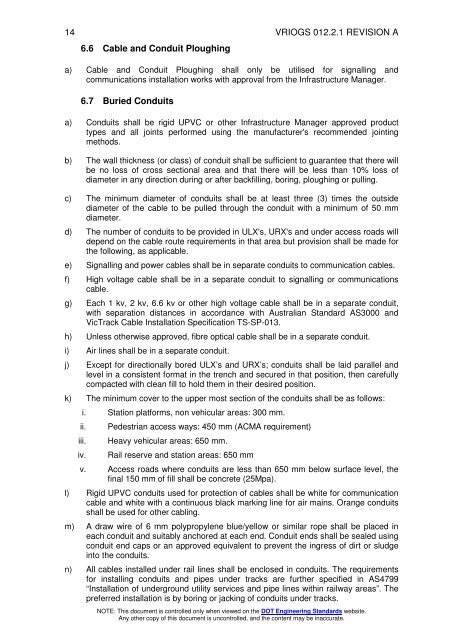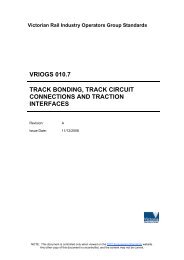VRIOGS 012.2.1 - Public Transport Victoria
VRIOGS 012.2.1 - Public Transport Victoria
VRIOGS 012.2.1 - Public Transport Victoria
Create successful ePaper yourself
Turn your PDF publications into a flip-book with our unique Google optimized e-Paper software.
14 <strong>VRIOGS</strong> <strong>012.2.1</strong> REVISION A<br />
6.6 Cable and Conduit Ploughing<br />
a) Cable and Conduit Ploughing shall only be utilised for signalling and<br />
communications installation works with approval from the Infrastructure Manager.<br />
6.7 Buried Conduits<br />
a) Conduits shall be rigid UPVC or other Infrastructure Manager approved product<br />
types and all joints performed using the manufacturer's recommended jointing<br />
methods.<br />
b) The wall thickness (or class) of conduit shall be sufficient to guarantee that there will<br />
be no loss of cross sectional area and that there will be less than 10% loss of<br />
diameter in any direction during or after backfilling, boring, ploughing or pulling.<br />
c) The minimum diameter of conduits shall be at least three (3) times the outside<br />
diameter of the cable to be pulled through the conduit with a minimum of 50 mm<br />
diameter.<br />
d) The number of conduits to be provided in ULX's, URX's and under access roads will<br />
depend on the cable route requirements in that area but provision shall be made for<br />
the following, as applicable.<br />
e) Signalling and power cables shall be in separate conduits to communication cables.<br />
f) High voltage cable shall be in a separate conduit to signalling or communications<br />
cable.<br />
g) Each 1 kv, 2 kv, 6.6 kv or other high voltage cable shall be in a separate conduit,<br />
with separation distances in accordance with Australian Standard AS3000 and<br />
VicTrack Cable Installation Specification TS-SP-013.<br />
h) Unless otherwise approved, fibre optical cable shall be in a separate conduit.<br />
i) Air lines shall be in a separate conduit.<br />
j) Except for directionally bored ULX’s and URX’s; conduits shall be laid parallel and<br />
level in a consistent format in the trench and secured in that position, then carefully<br />
compacted with clean fill to hold them in their desired position.<br />
k) The minimum cover to the upper most section of the conduits shall be as follows:<br />
i. Station platforms, non vehicular areas: 300 mm.<br />
ii.<br />
iii.<br />
iv.<br />
Pedestrian access ways: 450 mm (ACMA requirement)<br />
Heavy vehicular areas: 650 mm.<br />
Rail reserve and station areas: 650 mm<br />
v. Access roads where conduits are less than 650 mm below surface level, the<br />
final 150 mm of fill shall be concrete (25Mpa).<br />
l) Rigid UPVC conduits used for protection of cables shall be white for communication<br />
cable and white with a continuous black marking line for air mains. Orange conduits<br />
shall be used for other cabling.<br />
m) A draw wire of 6 mm polypropylene blue/yellow or similar rope shall be placed in<br />
each conduit and suitably anchored at each end. Conduit ends shall be sealed using<br />
conduit end caps or an approved equivalent to prevent the ingress of dirt or sludge<br />
into the conduits.<br />
n) All cables installed under rail lines shall be enclosed in conduits. The requirements<br />
for installing conduits and pipes under tracks are further specified in AS4799<br />
“Installation of underground utility services and pipe lines within railway areas”. The<br />
preferred installation is by boring or jacking of conduits under tracks.<br />
NOTE: This document is controlled only when viewed on the DOT Engineering Standards website.<br />
Any other copy of this document is uncontrolled, and the content may be inaccurate.

















